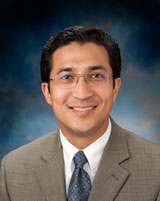 The ultimate goal of the University of Pittsburgh Medical Center's extensive big data initiative is simple: "It's about providing the appropriate level of care for the appropriate population at the appropriate time using the appropriate resources."
The ultimate goal of the University of Pittsburgh Medical Center's extensive big data initiative is simple: "It's about providing the appropriate level of care for the appropriate population at the appropriate time using the appropriate resources."
So says Rasu Shrestha, MD, the system's vice president of medical information technology. Dr. Shrestha is also one of the driving forces behind UPMC's efforts to tame the more than 4.2 petabytes of data generated by the 20-plus hospital system and insurer covering 2.1 million members into a useable and useful format.
The data, including information from imaging and radiology reports and data from electronic medical records, is aggregated on the backend through a solution UPMC implemented using dbMotion software, bringing together disparate silos of patient information from across the system. For Dr. Shrestha, however, this is just step one. "It's one thing to aggregate data; it's a whole different ball game to harness it, or bring out the meaning of the data elements," he says.
"For example, data pulled on medications listed in EMRs needs to be harmonized, or brought together, in order to do an enterprise-level analysis," says Dr. Shrestha. At UPMC, this medication data is aggregated to develop a baseline mapped to national standards, to allow analysis of a specific drug or drug class across the system.
There's one more step to fully using data, says Dr. Shrestha: data transformation. "You have to connect the dots and add logic to the relationships between data sets," he says. For example, the next logical step after tracking glycated hemoglobin levels is to connect that information to data on a patient's most recent foot exam, or other procedures and issues commonly linked with diabetes. The data then offers not only a picture of current health, but also helps hospitals "really extract important health information about a defined population," says Dr. Shrestha.
To help clinicians take full advantage of the transformed data, Dr. Shrestha and his team have developed a platform that allows this information to be seen clearly by end users throughout the hospital. "We're able to see the longitudinal view of the patient and able to look beyond a specific data set from one platform to see all the relevant, actionable elements," says Dr. Shrestha.
"The key question from physicians when they pull up a patient's chart is, 'What is the context?'" says Dr. Shrestha. Having this intelligent visualization of data available enables physicians to quickly see relevant history, including a patient's family history, past scans and tests and the patient's healthcare patterns. Having access to that data "helps bring the patient story to life," says Dr. Shrestha.
To other hospitals interested in taming their own data, Dr. Shrestha advises developing and following a clear enterprise vision for the ultimate use of the data. "The biggest mistake is to blindly adopt just the vendor's core vision," he says. "A hospital needs to have its own unique vision that articulates its specific needs." The vision may be driven by the hospital's goals, the population of patients served, the needs of the community or a combination thereof, and it may not always be completely compatible with the vendor's main vision. "Define your vision first, and then see how the vendor can step up and meet your needs; not vice versa," he says.
Dr. Shrestha also advises taking the time to build a strong foundational platform for data warehousing and analytics. A health system of any size will have information coming from several different sources. Although it may not be instantly gratifying, it is worth the investment of time, as much as the investment of capital, to create a truly interoperable system, he says.
"To all the hospital groups who say they can eliminate this need for interoperability by just going with a single vendor for all their solutions, I would counter by saying you'll never be dealing with just one vendor," says Dr. Shrestha. Even if a single EMR vendor is used within a hospital, any data solution should be able to accept data from ancillary clinical information systems, such as from radiology, and referring clinicians and other outside groups.
The influx of data will only increase as hospitals become increasingly responsible for managing the heath of populations. Being able to aggregate, harmonize and transform data from an expanding spectrum of sources will become increasingly important in the industry: "Using all available data intelligently is where we're heading in healthcare," says Dr. Shrestha.
At UPMC, the journey to fully use available data continues. "We have lots of aspirations around predictive models of care, and we're working on correlating clinical data to outcomes data, integrating financial data and data on individual physician performance as well," says Dr. Shrestha. "We're still working to connect all the dots."
More Articles on Big Data:
UHC, NYU Langone, Cleveland Clinic Partner for Automatic Data Intake Pilot
Lessons Learned on Making Health IT Investments
Learning From the Best: What HIM Looks Like at Geisinger, Intermountain
